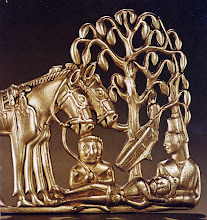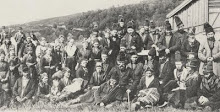* APRIL 20, 2009
Mongolians are calling the current situation a financial zud, invoking a local term for unusually harsh winters that devastate herds. After Mr. Sodnomdarjaa couldn't pay back a $2,700 loan, he says bank officials pressed him to sell his livestock -- which he used as collateral. The bank says he misrepresented the number of animals he owned, which he denies. Now a judge has ordered the seizure of Mr. Sodnomdarjaa's family home -- a tent -- if he doesn't come up with the rest of the money soon.
"We don't have any animals," says Mr. Sodnomdarjaa, sitting in his tent, heated by camel dung burned in a cast-iron stove. "How can we pay?"
Mongolian nomads' troubles show that the ravages of the economic crisis have spread to even the most remote parts of the world. More than a quarter of the households in Mongolia -- which has a population of about 2.6 million -- earn a living raising animals.
The credit crisis on the steppe has root causes similar to those of the subprime mess in the U.S. Some herders, betting on continued strong cashmere prices, borrowed more than they should have, and spent the money on the Mongolian equivalent of conspicuous consumption: motorbikes and solar panels to provide electricity for their tents. Banks, looking to cash in on rural prosperity in the good years, didn't pay enough attention to risk management and lent too freely, some bankers say.
Bankers say pressuring herders to sell animals and moving to foreclose on other collateral are last resorts. "We try our best to have flexible policies," says Daimaa Batsaikhan, deputy chief executive of Khan Bank. He said the bank's own forecasts for cashmere prices last year were "inaccurate" and that the bank has changed its risk-management practices.
He says his bank and other lenders have been working with herders. Khan Bank says it has restructured 7,000, or nearly 11%, of its outstanding herder loans, essentially extending the time borrowers have to repay. Ultimately, though, the money lent to herders is "money deposited by other Mongolians," the banker says, and it is the bank's responsibility to protect their interests.
Many banks have cut back on new lending. And a flood of forced sales has helped drive down prices for animals, skins and meat.
Munkhbat Tsedendorj, a 30-year-old animal dealer, based in Altai, the capital of the province where Mr. Sodnomdarjaa lives, says animals for sale in the city's central market have been fetching about half of what they were before the downturn. "I've been in this business 10 years, and I've never seen anything like it," he says, standing before a blue truck piled with skinned and frozen carcasses of sheep and goats. "They are bankrupting the herders."
Debt is a main topic of conversation here in Tsogt, a settlement of tents, government buildings and a few shops. Sheriffs from the provincial capital delivered a new round of court orders in January, barring defaulters from disposing of their possessions until courts can rule on foreclosure proceedings.
Naranchimeg Sonom, 45, says she had to sell her herd of more than 300 animals to pay off her defaulted loan. Otherwise, she says, the bank would have foreclosed on her tent, known here as a ger, and on the decorative mirror that graces its back wall. She says bank collection officers said: "You are all beggars. Why did you take a loan if you can't pay it back?"
In recent years, commercial banks started competing to extend credit to herders, who typically earn significant cash just twice a year -- in the spring through cashmere and wool sales, and in the autumn through sales of animal skins and meat. The money helped families get through the times in between, usually at a cost of between 2% and 3% in interest per month.
Troubles began when demand for cashmere started falling after the U.S. slipped into recession in late 2007. By last June, the price for cashmere in Mongolia had fallen by more than 33% from a year earlier, hitting about 28,000 togrog, or $19, a kilogram. Prices have dropped further. "Everyone says now that we are just taking care of banks' animals," says Janchiv Nyambuv, a 65-year-old herder who borrowed 500,000 togrogs, or $350, that he must repay in May.
Herders who have sold their herds to repay loans have struggled to find other sources of income. Purevdelger Budkhuu, a 38-year-old widow, says she was forced to sell her family's 128 goats and sheep after she couldn't pay back a six-month loan of $1,270. Now, she and her two children live in a tent near Altai's grimy central market. She says she has looked for work, to no avail, at shops, restaurants and hotels. "I don't know what to do. I can't go back to the countryside because I have no animals," she says. "And I can't stay here because I can't find a job."
Mr. Sodnomdarjaa says he went to a Khan Bank branch at the beginning of 2008 to get a loan to help repay those who had given him animals to start his herd and buy food and clothes for his wife and four children.
Mr. Sodnomdarjaa and his wife, Altantsetseg Tseyentsend, 38, say they intended to repay the loan by selling cashmere and other products from the 90 or so goats and sheep they owned, as well as from another more than 170 animals they were looking after for others. "We'd never taken a loan before" but, Mr. Sodnomdarjaa says, the bank officer he talked to seemed eager to give him money.
The bank says it checked government records of herders' animals, which said Mr. Sodnomdarjaa owned 267 animals and had no reason to doubt their accuracy. The bank said that after Mr. Sodnomdarjaa defaulted, it discovered just 90 of the animals belonged to him. Bank officials said that if they had known that, he wouldn't have qualified for such a large loan. Mr. Sodnomdarjaa denies any wrongdoing and says bank officials in Tsogt never asked him about the makeup of his herd.
When the loan was due, Mr. Sodnomdarjaa says he was unable to pay. He says the bank eventually pushed him to sell his animals. The bank says Mr. Sodnomdarjaa still owes more than 2.7 million togrogs, or about $1,900.
Mr. Sodnomdarjaa says he and his wife are determined to repay the loan and plan to look for construction or mining work. These days, the couple cares for other families' camels. Their only regular compensation is the right to milk the herd. About half the milk, they drink. The other half they sell. Two months' earnings are about enough to buy a sack of flour.
"The kids want to eat meat, but we have nothing to give them," says Mr. Sodnomdarjaa.
Write to Gordon Fairclough at gordon.fairclough@wsj.com
Printed in The Wall Street Journal, page A1
Copyright 2009 Dow Jones & Company, Inc. All Rights Reserved

Mongolian Nomads: Their Lifestyle and Animals
Author: Casey Beck
“What do you think about Americans? Generally, I mean.”
I realized I was posing an unfair question to Jagaa, a herder here in central Mongolian. She splits her time worrying about her 500 or so animals, her husband and her three small boys, one of whom who was suffering from the mumps. She had already mentioned the increasing difficulties of herding, on account of more severe winters, more erratic spring weather and over-grazing from her neighbors’ encroaching herds. On top of it all, she had a more atypical concern: a semi-sickly, inquisitive American girl, me.
Though I could barely manage to piece together two sentences in Mongolian and the dramatic change in climate and diet had brought me sickness for nearly four consecutive weeks, I still mustered the strength to ask uncomfortably pointed questions.
Jagaa, however, chuckled. She answered through an interpreter, “Well,” she glanced furtively in my direction and began to speak in her frank way, “Americans are much weaker than Mongolians.” She continued unabashedly, as I unsuccessfully tried to stifle my indignation. Jagaa, in turn, went on to prove her point unequivocally.
“You get tired quickly.” I shifted, puffing up my chest to cover my weakened state. “You can’t see.” I was her case in point here, as my daily ritual with my contacts caused slack-jaw stares from the family and provided ceaseless amusement. Some mornings Jagaa would even call the rest of the family over, to ensure they didn’t miss the show.
But she wasn’t done. “You have put weird things in your mouth to make your teeth straight.” She flashed a smile, highlighting her own perfectly straight teeth. My teeth are straight too, but only after four years of braces and a retainer that I am supposed to wear the rest of my life, and she knew it.
“I think you are very nice, and I am happy you have come to stay with us, but as an American, you are weaker. Mongolians come from a pure bloodline, and it is strong,” she ended conclusively. She had a point. The American lifestyle has softened its citizens, while the nomadic lifestyle of half of Mongolia’s two million people has maintained the physical and mental strength of its population.
In the United States, many people visit doctors several times each year. I think it’s fair to say that, over the past 200 years, most American citizens have adapted to the availability of health care. In truth, even America’s poor have better medical care than most Mongolians. Living in the countryside of Mongolia does not allow room for physical weakness.
Jagaa lived one hour from the nearest town, which was another several hours from the closest big city with a hospital and 12 hours in a four-wheel drive vehicle from Ulaanbaatar, the country’s capital and only modern metropolitan area. Three times a year, Jagaa and her husband move their portable, one-room house—a ger made of a thick felt from their own animals—between established grazing grounds.
Each day, one of them would spend hours trailing their large herd of goats and sheep. Sometimes, they would take a horse; often, they would go on foot. Jagaa's family also cared for several cows and horses. The chores the animals' care would take up to 10 hours a day, and during the birthing season—when I visited—the family would spend nearly 14 hours a day with the animals.
The Mongolian nomadic lifestyle is dependent on animals. Food, shelter, and drink all stem from a family's herd. Animals are also the only means of providing for a nomadic child's education, as a family will sell a goat to pay for a child's school costs. For these families, their animals provide material wealth in addition to the basic necessities. Tending to their animals is the single most critical facet of the life of a Mongolian herder.
It is no wonder why the Mongolian physicality is so close to perfection, especially when compared with our American lifestyle.




